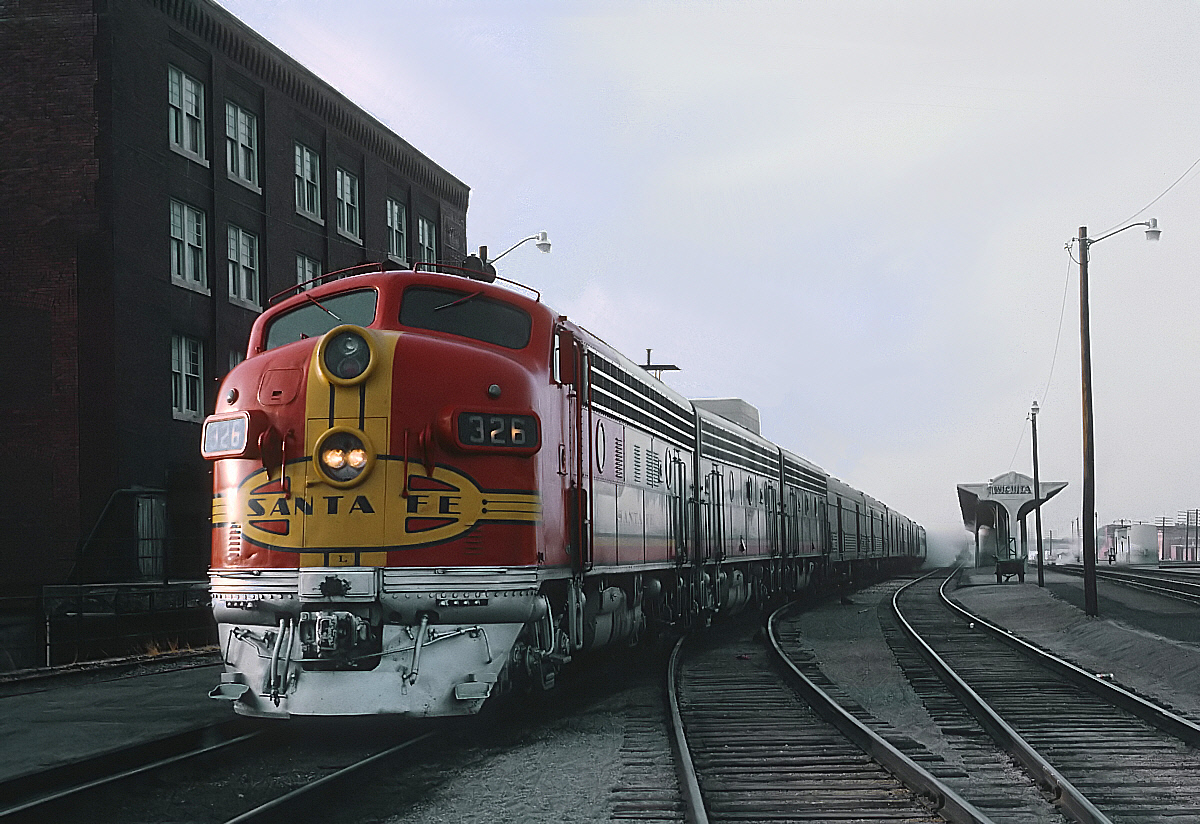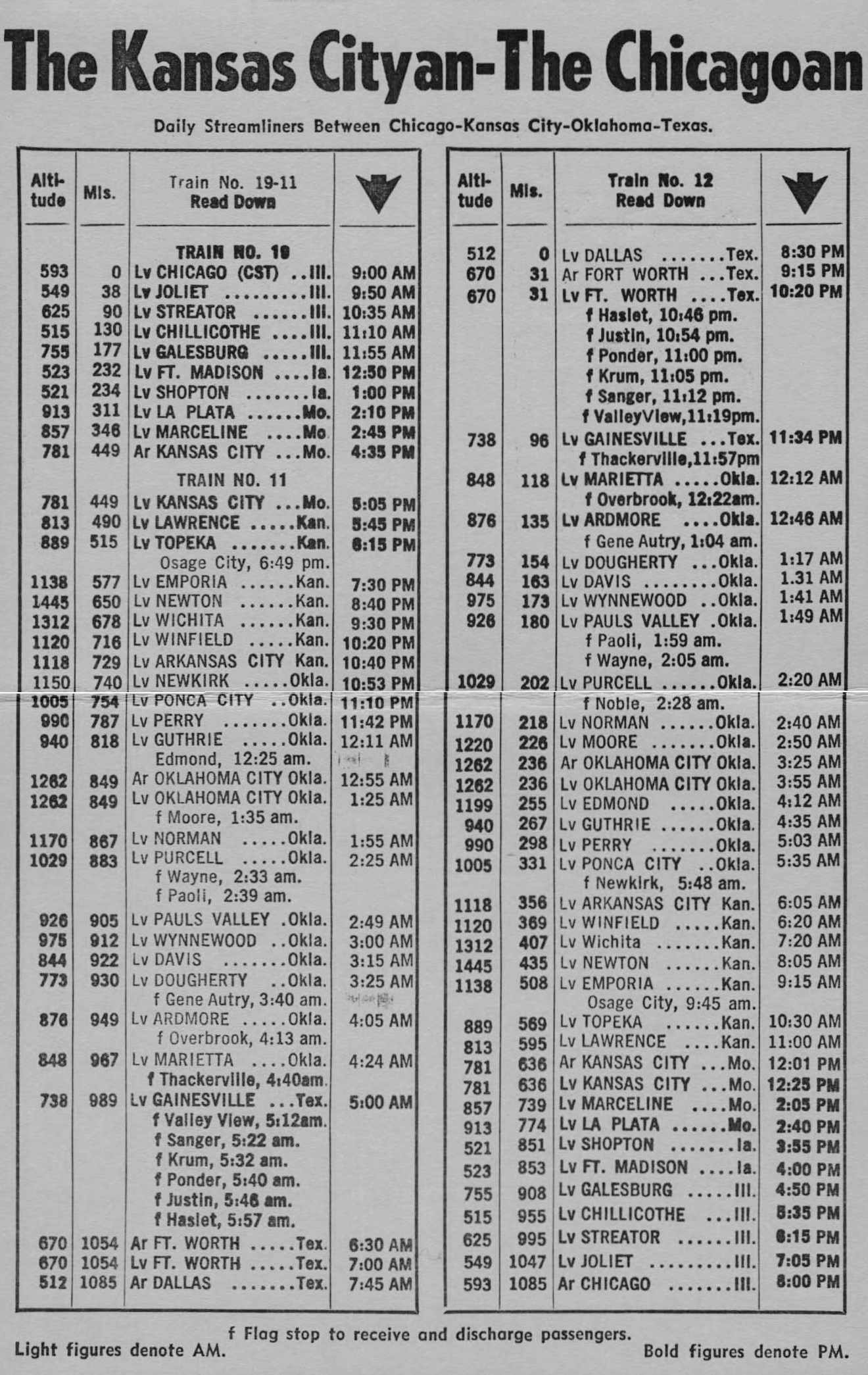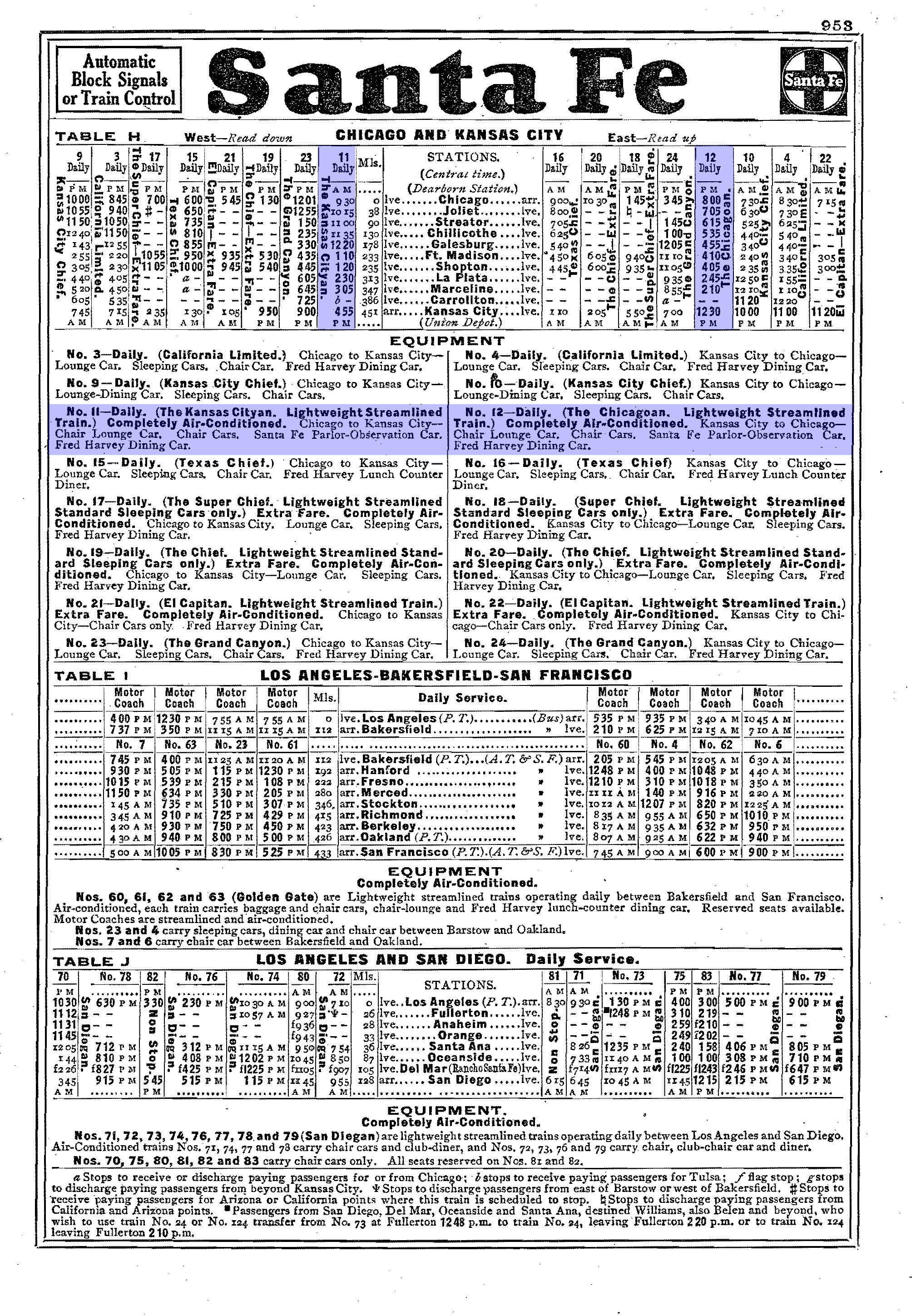AT&SF's "Chicagoan"/"Kansas Cityan" (Train)
Last revised: September 11, 2024
By: Adam Burns
One of Santa Fe's lesser-known streamliners launched during the 1930s was the Chicagoan/Kansas Cityan. This train served its namesake cities and as expected provided the best of services the AT&SF had to offer.
It was diesel powered from the very beginning utilizing handed down equipment from the original Super Chief incarnation. In succeeding years the schedule was extended, first into Oklahoma and then later as far south as Texas.
When the railroad launched the Texas Chief after World War II this train took precedent over its counterpart.
As patronage declined throughout the 1950s the Santa Fe was eventually forced to institute cutbacks which saw the Chicagoan/Kansas Cityan discontinued before the end of the 1960s.
Photos
 Santa Fe F7A #326-L is stopped at Union Station in Wichita, Kansas with train #12, the "Chicagoan," on March 27, 1967. Roger Puta photo.
Santa Fe F7A #326-L is stopped at Union Station in Wichita, Kansas with train #12, the "Chicagoan," on March 27, 1967. Roger Puta photo.History
Through the euphoria and allure of new streamliners christened during the 1930s, particularly on the AT&SF who spared no expense in making sure it provided one of the top transcontinental trains in the West (and eventually boasted an entire fleet of legendary names), some trains were lost in the glitz and glamor.
Such was the case for the Chicagoan/Kansas Cityan. This train, the former named for the eastbound run (#12) and the latter the westbound (#11, it then operated as far south as Wichita, Kansas), was launched only a few years after the Super Chief hit the rails.
It officially embarked from Chicago on April 17, 1938 and carried a seven-car consist of lightweight, stainless equipment manufactured by the Budd Company (a builder the AT&SF often turned to over the years).
The initial cars included:
- RPO (Railway Post Office)-baggage
- A trio of 52-seat chair cars (coaches)
- A bar lounge-coach (26 chairs)
- 48-seat diner
- Round-ended parlor-observation
Power was initially provided by a few of the Santa Fe's original E1 diesels, Electro-Motive (EMC) products manufactured in 1937 for the original Super Chief consist; they wore the first version of the iconic Warbonnet livery designed specifically for them by General Motors' styling department artist Leland A. Knickerbocker.
However, they operated for only a few weeks before being replaced by the Santa Fe's famous set of EMC boxcabs, #1A and #1B, which had powered the pre-streamlined Chief beginning in early 1936. The units were rebuilt at the railroad's Topeka (Kansas) shops with canopied cabs and a somewhat streamlined nose while wearing a version of Warbonnet paint.
At A Glance
7 Hours and 25 Minutes (Kansas Cityan) 7 Hours and 30 Minutes (Chicagoan) |
|
11 (Westbound/Southbound) 12 (Eastbound/Northbound) | |
Union Station (Kansas City) Dearborn Station (Chicago) |
These units remained power for the Chicagoan/Kansas Cityan until around 1940 when E1s again took over (the entire fleet was later rebuilt with the classic "Bulldog" nose in 1953 and classified as E8AMs, a design that came to define Electro-Motive's cab models).
In the coming years other power included E6s while the train itself saw service extended first to Oklahoma City and then as far south as Dallas. According to Mike Schafer and Joe Welsh's book, "Streamliners: History Of A Railroad Icon," the Chicagoan/Kansas Cityan operated between Chicago and Wichita during the day while the rest of the trip south occurred during the overnight hours.
As time passed consists changed; in December of 1939 the first 14-section, lightweight sleepers were added as well as a baggage-chair car, baggage-chair-dormitory, and an RPO-baggage.
Throughout the 1940s there were other various swaps in equipment from the addition of more chair cars to sleepers. During 1954 the Santa Fe began receiving its new "Big Dome" lounges from Budd, fourteen in all.
Meant to equip the Chicagoan/Kansas Cityan and El Capitan (as well as the yet-to-be launched transcontinental San Francisco Chief) they were acquired largely due to the popularity of the earlier "Pleasure Domes" and offered full-length dome viewing with a 57-seat capacity along with an 18-seat lounge according to Steve Glischinski's, "Santa Fe Railway."
Interestingly, even though the Santa Fe owned few E units, predominantly relying on F3s and F7s for passenger assignments, the six-axle locomotives often led the Chicagoan/Kansas Cityan throughout the years.
Timetable (September 15, 1966)

Unfortunately, the postwar era of rail travel was hard on most railroads although the Santa Fe weathered the declines better than most, in no small part thanks to its high speed-running and unparalleled services.
During 1955 the Chicagoan/Kansas Cityan lost its full-service diner, replaced by a lunch-counter diner although the train continued fielding many chair cars along with a few sleepers (complementing a parlor-observation and a handful of head-end cars).
By the end of the decade even the AT&SF was having a difficult time justifying so many named trains on its timetable in the face of falling patronage. This was particularly true with the Chicago-Texas market then served by two notable streamliners, the Texas Chief and Chicagoan/Kansas Cityan.
Timetable and Consist (1952)
Final Years
Much to its chagrin, by the 1960s the proud Santa Fe was finally forced to initiate cutbacks within its passenger fleet, no longer able to ignore the growing red ink. On April 18, 1968 the Chicagoan/Kansas Cityan made its final run (until the end the train was still powered by those rebuilt E8AMs) leaving the Texas Chief as the railroad's last remaining long-distance train in that market.
This, of course, wasn't the only example of service reductions; the original Chief was also canceled in 1968, as was the Golden Gate (a regional streamliner serving Oakland and Bakersfield, California), and the AT&SF combined its flagship Super Chief with the highly regarded El Capitan during the decade.
Sources
- Glischinski, Steve. Santa Fe Railway. St. Paul: Voyageur Press, 2008.
- Schafer, Mike and Welsh, Joe. Streamliners, History of a Railroad Icon. St. Paul: MBI Publishing, 2003.
- Yenne, Bill. Santa Fe Chiefs. St. Paul: TLC Publishing Company, 2005.
Recent Articles
-
Wisconsin Dinner Train Rides In North Freedom!
Jan 06, 26 10:18 PM
Featured here is a practical guide to Mid-Continent’s dining train concept—what the experience is like, the kinds of menus the museum has offered, and what to expect when you book. -
Pennsylvania Dinner Train Rides In Boyertown!
Jan 06, 26 06:48 PM
With beautifully restored vintage equipment, carefully curated menus, and theatrical storytelling woven into each trip, the Colebrookdale Railroad offers far more than a simple meal on rails. -
North Carolina ~ Murder Mystery ~ Dinner Train Ride
Jan 06, 26 11:26 AM
While there are currently no murder mystery dinner trains in the Tarheel State the Burgaw Depot does host a murder mystery dinner experience in September! -
Florida's - Murder Mystery - Dinner Train Rides
Jan 06, 26 11:23 AM
Florida, known for its vibrant culture, dazzling beaches, and thrilling theme parks, also offers a unique blend of mystery and fine dining aboard its murder mystery dinner trains. -
New Mexico's - Wine Tasting - Train Rides
Jan 06, 26 11:19 AM
For oenophiles and adventure seekers alike, wine tasting train rides in New Mexico provide a unique opportunity to explore the region's vineyards in comfort and style. -
Ohio's - Wine Tasting - Train Rides
Jan 06, 26 11:14 AM
Among the intriguing ways to experience Ohio's splendor is aboard the wine tasting trains that journey through some of Ohio's most picturesque vineyards and wineries. -
Connecticut's Thomas The Train Rides
Jan 06, 26 11:06 AM
For 2026, the tour stop at Essex brings Thomas (and Percy, too) to the historic Valley Railroad for a full day of events for the kids. -
Maryland's Thomas The Train Rides
Jan 06, 26 11:00 AM
In 2026, the B&O Railroad Museum in Baltimore welcomes the Let’s Rock, Let’s Roll Tour with four event days that combine a Thomas-themed excursion with other activities. -
Tennessee's Thomas The Train Rides
Jan 06, 26 10:51 AM
Set on the grounds of one of the Southeast’s best-known operating railroad museums, the Thomas the train event blends kid-friendly fun with the unmistakable sights, sounds, and atmosphere of a real wo… -
Georgia's Thomas The Train Rides
Jan 06, 26 10:44 AM
Day Out With Thomas is set to roll back into Cordele in 2026, bringing Thomas the Tank Engine and a full family festival to the SAM Shortline at Georgia Veterans Memorial State Park. -
Staten Island Rapid Transit
Jan 06, 26 10:02 AM
The Staten Island Rapid Transit has long served Staten Island since the 19th century and today is known as the Staten Island Railway. -
New York Dinner Train Rides In The Adirondacks!
Jan 05, 26 09:45 PM
Operating over a restored segment of the former New York Central’s Adirondack Division, the Adirondack Railroad has steadily rebuilt both track and public interest in passenger rail across the region. -
Ohio Dinner Train Rides On The CVSR!
Jan 05, 26 08:32 PM
While the railroad is well known for daytime sightseeing and seasonal events, one of its most memorable offerings is its evening dining program—an experience that blends vintage passenger-car ambience… -
Pennsylvania's - Wine Tasting - Train Rides
Jan 05, 26 01:08 PM
Wine tasting trains are a unique and enchanting way to explore the state’s burgeoning wine scene while enjoying a leisurely ride through picturesque landscapes. -
West Virginia - Wine Tasting - Train Rides
Jan 05, 26 01:02 PM
West Virginia, often celebrated for its breathtaking landscapes and rich history, offers visitors a unique way to explore its rolling hills and picturesque vineyards: wine tasting trains. -
Virginia - Wine Tasting - Train Rides
Jan 05, 26 12:58 PM
Wine tasting trains in Virginia provide just that—a unique experience that marries the romance of rail travel with the sensory delights of wine exploration. -
Utah - Wine Tasting - Train Rides
Jan 05, 26 12:37 PM
Utah, a state widely celebrated for its breathtaking natural beauty and dramatic landscapes, is also gaining recognition for an unexpected yet delightful experience: wine tasting trains. -
Kentucky Valentine's Train Rides
Jan 05, 26 12:31 PM
If you’re looking for a date night that feels a little more cinematic than the usual reservation-and-a-movie routine, Bardstown’s My Old Kentucky Dinner Train delivers the kind of evening you remember… -
Pennsylvania Valentine's Train Rides
Jan 05, 26 12:12 PM
Tucked amid the rolling farmland of Lancaster County, Pennsylvania, the Strasburg Rail Road stands as one of the most celebrated and successful heritage railroads in North America. -
New York's - Murder Mystery - Dinner Train Rides
Jan 05, 26 11:01 AM
New York State, renowned for its vibrant cities and verdant countryside, offers a plethora of activities for locals and tourists alike, including murder mystery train rides!





















